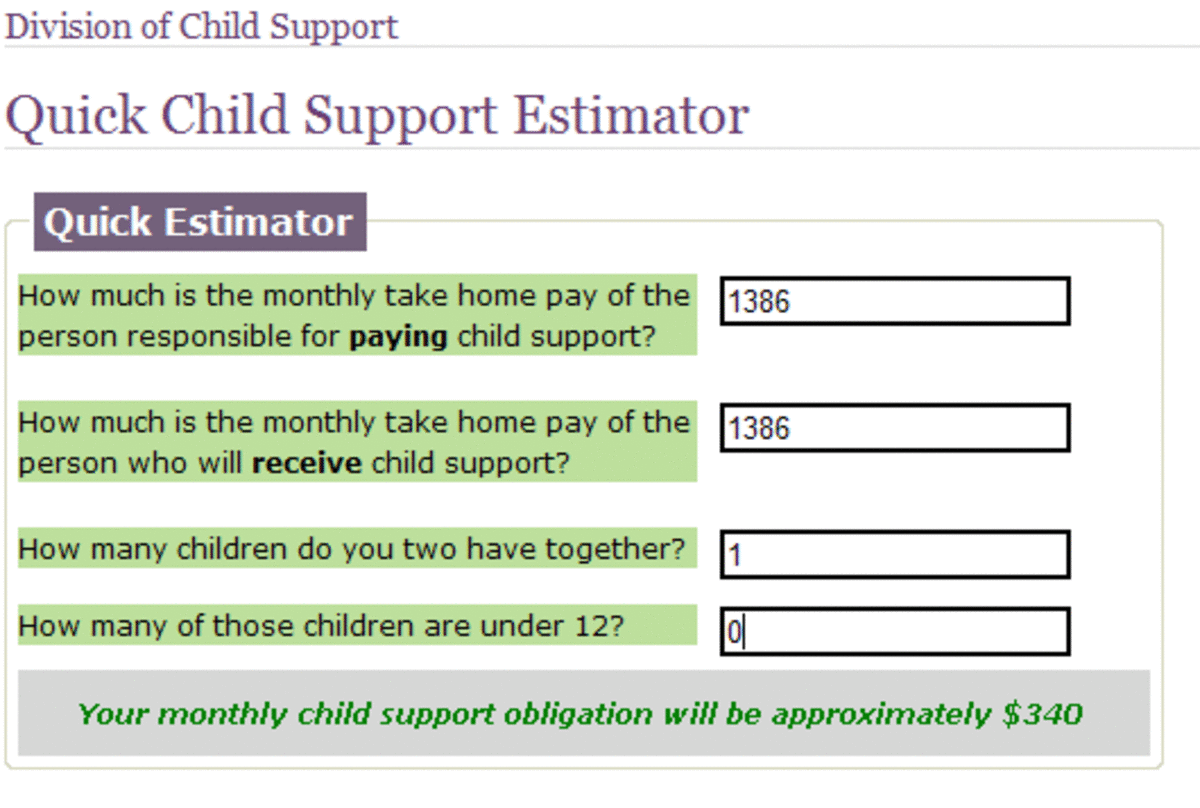An Overview of Child Support Rules and Regulations
Overview of the Federal Child Support Program
The federal child support program was set up under Title IV-D of the Social Security Act in 1975. The federal Office of Child Support Enforcement or OCSE is under the Department of Health and Human Services. The states establish paternity, enforce support orders and collect child support monies before distributing them to the custodial parents.
The federal government offers states services and assistance, such as garnishing federal tax refunds before giving it to the state where the mother lives and managing the Federal Parent Locator Service to track deadbeat parents across state lines.
Federal child support services can be used in conjunction with state child support services, such as parent locating services and garnishments of the wages of a military serviceman.

Establishing Paternity and Fatherhood in Child Support Cases
If you have reason to suspect you are not the father, do not sign the birth certificate, acknowledgement of paternity or paternity acknowledgement. Women are pressured to sign a paternity affidavit in the hospital because they want to reduce claims for public assistance and garner the name of a second person to bill for the child’s birth.
The husband is presumed to be the father of the child, even if she may have had an affair. The husband is assumed to be the father of a child born no later than 300 days after a divorce, even if the divorce was due to adultery, unless he challenges the paternity.
Some states assume that the man living with the mother is the father under common law marriage statutes. In these cases, he will be named as the father or pressured to sign a paternity acknowledgement.
If you sign the paternity acknowledgement, you will be held liable for child support even if a DNA test later shows you are not the father. Likewise, a child acknowledged with the paternity affidavit gains inheritance rights, life insurance benefits, health insurance benefits and Social Security dependent benefits.
You have the right to refuse to sign the paternity acknowledgement and get DNA testing of the child. If the mother identifies a man as the father, the alleged father can request a DNA test to challenge paternity, though it is his legal obligation to pay for the DNA test. When seeking DNA testing to establish paternity, check the list of accredited laboratories located in your state.
Always refuse to sign a paternity affidavit and get DNA testing if there is any concern about the child’s paternity. Once you are legally recognized as the father, it is almost impossible to get out of child support, even if the mother admits you are not the father or DNA tests prove you are not the father.
Find Your State's Child Support Website
- List of State and Territory Child Support Offices
Child Support Websites and General Contact Information - OSCE
When Are Child Support Orders Issued?
Child support orders are a standard part of divorce decrees. Child support orders commonly arise when a child is born out of wedlock and the mother seeks support from a man she no longer lives with. Child support services and child support orders are automatically issued when a woman seeks assistance from Medicaid and Temporary Assistance for Needy Families (TANF), to reimburse the state for aid that was paid on behalf of the child. Placement of the child in federally assisted foster care will also trigger child support orders.
Always respond to a paternity suit and the formal complaints served by the courts. Failure to respond to the complaint will result in a default judgment of paternity and an order for child support. Disestablishing child support after this point is much more difficult and costly than trying to challenge paternity and child support orders after the court has determined it.
What Happens If You Don’t Pay the Amount Ordered by Child Support Orders?
The federal government has a wide array of penalties at its disposal for those who don’t pay child support orders. Unpaid child support may be collected through wage garnishments, seizure of bank accounts, liens on real property and garnishment of federal and state income tax refunds. The only limit on child support liens is that it cannot be attached to property necessary for someone to earn a living, such as a big rig driver’s truck or a mechanic’s tools.
The government can deny licensing to those who have unpaid child support, such as revoking driver’s license, professional licenses, and recreational licenses like hunting permits and fishing licenses. The federal government may deny those with unpaid child support a passport. A passport will not be issued or renewed if someone has unpaid child support of more than $2,500.
You can go to jail for unpaid child support exceeding $5,000 or failing to pay child support for over a year.
What Are Your Rights If You Can’t Pay the Child Support Ordered?
Either parent has the right to review the child support order every three years. You can request a review of the child support obligation if there has been a substantial change in circumstances, such as adding the child to your health insurance or job loss.
If your wages have dropped or you’ve lost your job, seek legal advice immediately to have the child support order modified. Child support orders remain in effect regardless of your wages, so a child support order set at 10% of an $8,000 a month income for $800 a month to be paid to the mother remains in effect even if your pay drops to $3,000 a month. Your child support obligation remains $800 a month regardless of your ability to pay until the order is modified. Child support can be deducted from your unemployment compensation, disability benefits and Social Security benefits.
Talk to an attorney if you are sent to jail about modifying your child support order so that you don't get arrested for failure to pay child support shortly after getting out of prison.
Unpaid child support debt cannot be discharged in bankruptcy. Filing for bankruptcy will not even act as a hold on the next child support payments due, though it will stay an impending foreclosure temporarily.
When Do You Need to Modify a Child Support Order?
Get legal counsel as soon as you lose your job or have your wages cut so that the child support obligation isn’t unpaid when you try to choose between paying rent and paying child support, much less figuring out on how to live on $200 a month after child support is deducted from your much smaller check.
Seek a modification of the child support order when your child custody arrangements change. Shifting to a shared custody agreement where each parent has the child 50% of the time can eliminate child support obligations, but the child support order will remain in effect, deducting money from your check and sending it to the mother until it is modified.
If the father is under 18, he can seek to have the child support order delayed until he finishes school.
Child support orders should be challenged if the other parent seeks increased payments and your income hasn’t gone up and when the child support order doesn’t leave you enough to live upon.
If the child has been placed for adoption or has been adopted by the other parent’s partner, you can seek the termination of the child support order.
Always challenge child support orders issued regarding children you did not previously knew existed. It is possible that the mother named you as the only person whose contact information she had, the only potential parent she was willing to have involved in the child’s life or the person with the greatest financial assets.
You can seek a modification of the child support order if you or the mother moves to another state. Child support guidelines vary from state to state. Some states only take the non-custodial parent’s income into account. Other states use an income share model that bases child support on both parents’ incomes. If child support in your state factors the custodial parent’s income into the equation and that parent gains employment or finds a higher paying job, seek an adjustment of the order. The court doesn’t care if the man is paying child support to a woman making more than he does, as long as the original court ordered amount is paid each month.
Child support earnings may drop after the child finishes high school or gains employment, but this isn’t automatic.
You can request a modification of a child support order after you have remarried or had additional children. However, the child support obligations are determined by formulas set by the state, and you may not be able to get a reduction in child support payments to an older child because you’ve had another one.
Child support orders will be modified if a new child support order is filed for another child and the total amount would otherwise not leave him enough to live upon. Each mother will then receive a reduced amount of support and percentage of the support collected.
Child support orders can be modified by changes in non-financial support, such as the father adding the child to his health insurance and seeking a proportional reduction in the financial support.
What Are My Options If I Paid Child Support or Supported Her, But the Court Says I Didn’t?
It is possible to arrange a child support agreement between the parents without a formal court order. It is then the non-custodial parent’s obligation to make payments on time and in full. Failure to pay child support per the agreement will result in a court judgment against you for the unpaid child support.
Never give the child’s mother cash to support the child; the handwritten receipts may not be recognized by the court. Pay child support to the mother via check or money order or electronic funds transfer; these payment methods create a paperwork trail that can prove you paid child support if she later says you didn’t.
Dropping off a case of diapers and bag of groceries is nice, but it isn’t considered sufficient support for the child.








